Optimized at frequencies beyond traditional industry targets to support emerging applications
How to select the Right Power Management IC (PMIC) for Your Voltage Regulation Needs?

As we know everything in our modern world depends on electronics, from communication to transportation and education to experiments. Have you ever wondered, how all these pieces of equipment with hundreds or thousands of electronic parts run? How do they run different parts with different voltage and power ratings in the same equipment? That's where the power management IC or PMICs come into play.
Power Management ICs (PMICs) are integrated circuits that manage the power requirements of electronic circuits. They integrate various such as voltage regulation, power sequencing, battery management, and power monitoring. By consolidating these functions, PMICs help reduce the size and complexity of electronic designs, improve efficiency, and extend battery life. In this article, we will focus on voltage regulators and go through popular PMICs within that context. Also if you are looking for a one-stop global electronics market to source your PMICs or any other electronic components, you should check out WIN SOURCE Electronics, more about them at the end of this article.
What is Voltage Regulator PMICs?
Voltage regulators are PMICs that maintain a constant output voltage despite variations in input voltage and load current. They play a crucial role in protecting electronic components from damage caused by voltage fluctuations. Voltage regulators can be generally categorised into two main types: Linear Regulators and Switching Regulators.
Linear Regulators
These regulators provide a stable output voltage by dissipating excess power as heat. They are simple to use and provide low noise, making them suitable for noise-sensitive applications. Common types include:
- Low Dropout Regulators (LDOs): These regulators can operate with a very small difference between the input and output voltages, making them efficient for low-voltage applications.
Switching Regulators
These regulators use a switching element to convert the input voltage to a desired output voltage efficiently. They are more complex but offer higher efficiency compared to linear regulators. Common types include:
- Buck Converters: These step-down regulators convert a higher input DC voltage to a lower output DC voltage.
- Boost Converters: These step-up regulators increase the input DC voltage to a higher output DC voltage.
- Buck-Boost Converters: These regulators can step up or step down the input DC voltage to maintain a stable output voltage.
Now let’s look at some very popular voltage regulator PMICs
LM78xx

The LM78xx series fixed-voltage linear regulators are capable of providing a regulated output voltage with output current capabilities of up to 1.5A. They are available in several fixed output voltages, such as 5V (LM7805), 9V (LM7809), and 12V (LM7812). These regulators are known for their robust design, including features like thermal shutdown, internal current limiting, and safe area protection. The LM78xx series is widely used in power supply designs due to its ease of use and reliability. They are cheap and widely available. But as the name suggests they are linear regulators and have less efficiency compared to other newer LDOs or switching regulators. But nonetheless, they are still very popular and easy to integrate into a circuit.
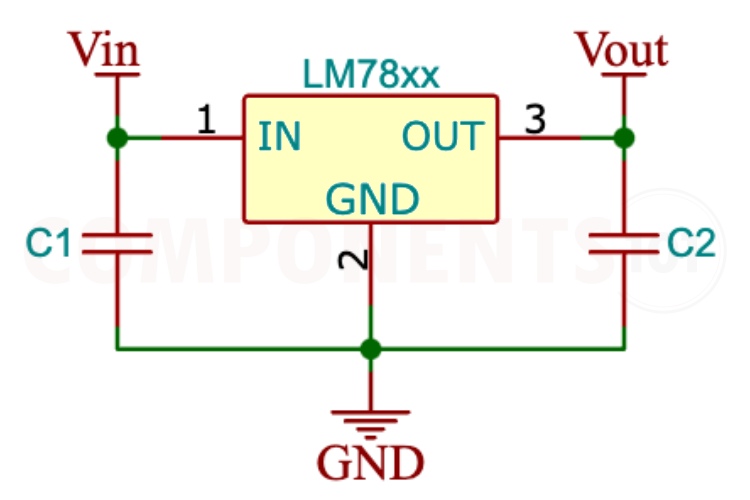
AMS1117
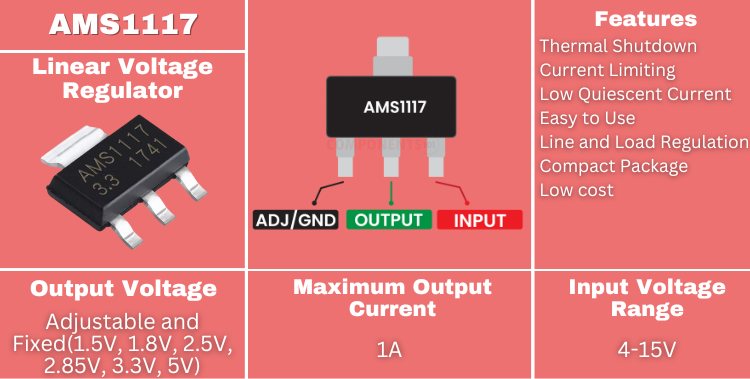
The AMS1117 is a popular LDO regulator that provides a fixed output voltage from an input voltage of up to 15V. They are available in different output voltages running from 1.5V to 5V. It can supply a current of up to 1A with a typical dropout voltage of 1.1V at full load. The AMS1117 is known for its ease of use, with internal current limiting and thermal shutdown features, ensuring safe operation under all conditions. This regulator is widely used in a variety of consumer electronics and embedded system projects due to its reliability and simplicity. Same as the LM7805, the AMS1117 is also extremely popular, cost-effective and easy to procure.

LM317
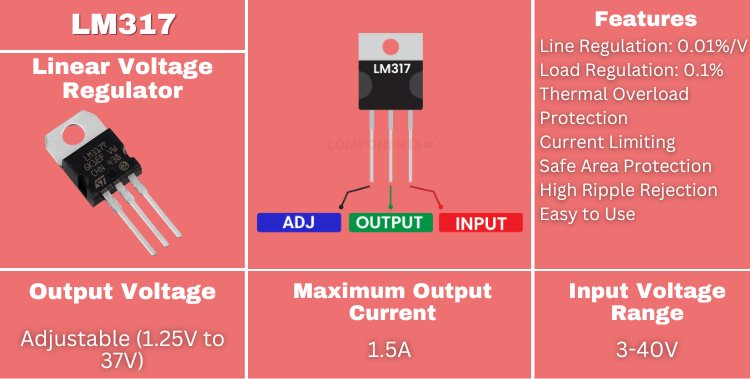
The LM317 is an adjustable voltage regulator that can provide an output voltage range of 1.25V to 37V with an output current capability of up to 1.5A. It is highly versatile, allowing users to set the desired output voltage using two external resistors. The LM317 includes current limiting, thermal overload protection, and safe area compensation, making it a reliable choice for a wide range of power supply applications. Its flexibility and robustness have made it a staple in many electronic designs. It can also be used as a simple current regulator with a bare minimum of extra components.
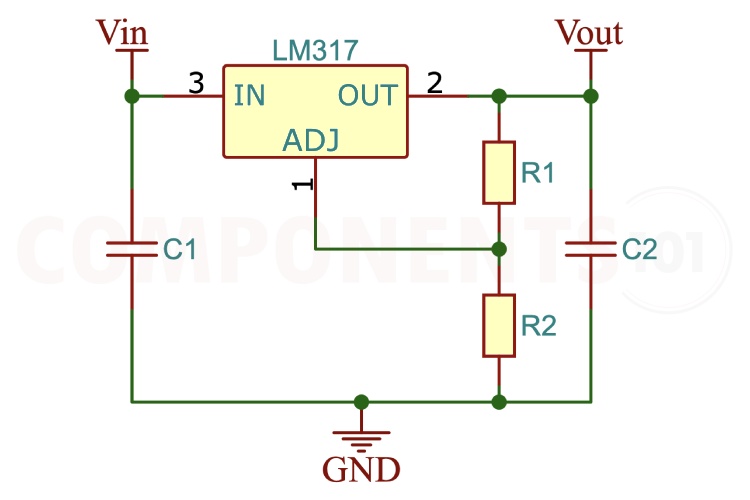
AP2112
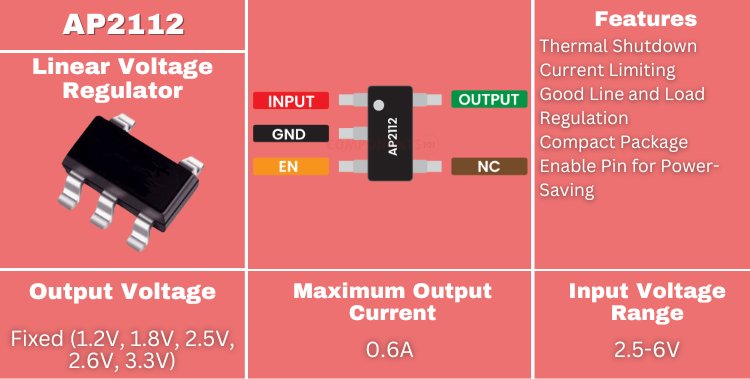
The AP2112 is a low-dropout (LDO) linear regulator designed for stable output voltage with very minimal voltage drop, for low-power applications. It operates within an input voltage range of 2.5V to 6V, offering fixed output voltages such as 1.2V, 1.5V, 1.8V, 2.5V, 3.0V, and 3.3V, as well as an adjustable version. The AP2112 can deliver up to 600mA of continuous output current, making it suitable for a variety of power-demanding applications. It features a low dropout voltage of typically 250mV at a 600mA load(for the 3.3V variant), ensuring efficient operation even with a minimal voltage difference between input and output. Additionally, its quiescent current is remarkably low, typically around 55µA, which is ideal for battery-powered devices where energy efficiency is crucial. The AP2112 also includes essential protection features such as current limiting and thermal shutdown, enhancing its reliability and safety in various applications.
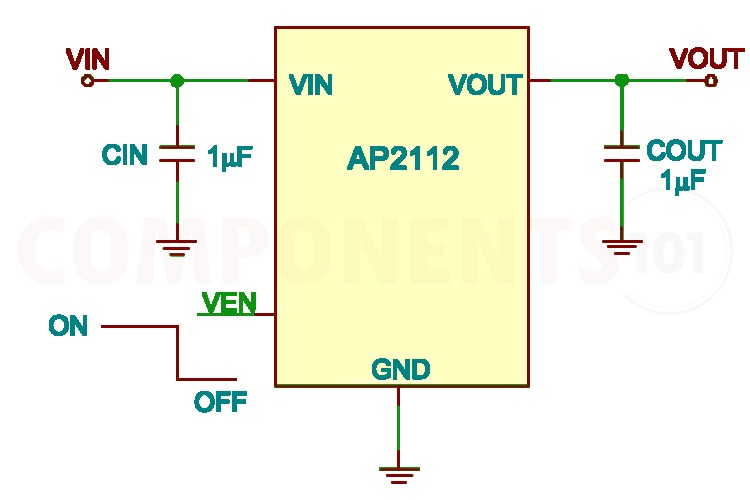
MIC5219
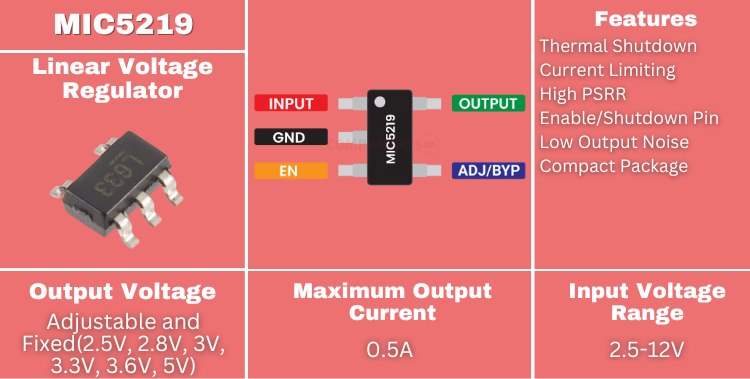
The MIC5219 is a high-performance LDO regulator with a low dropout voltage and a low ground current, which makes it suitable for battery-powered applications. It offers an output voltage accuracy of ±1%, and the device can deliver up to 500 mA of output current. The MIC5219 also features a logic-compatible enable/shutdown control input, overcurrent and thermal shutdown protections, and is available in several fixed and adjustable output voltage versions. Its ultra-low dropout voltage and high-power supply rejection ratio (PSRR) makes it ideal for noise-sensitive applications.
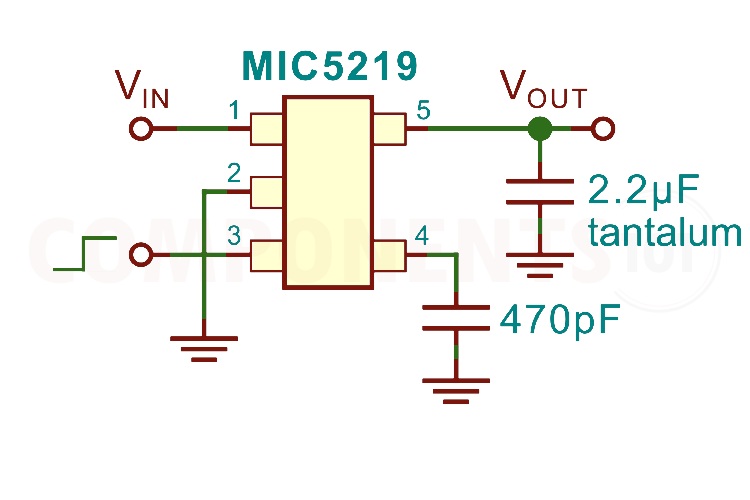
LM2576
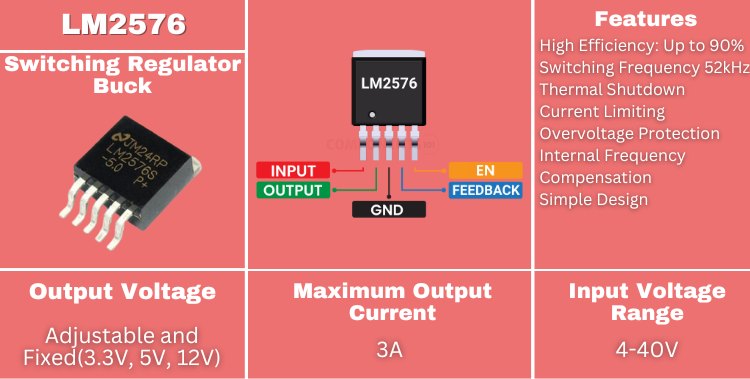
The LM2576 is a popular switching regulator designed for efficient power conversion with a fixed output voltage of 3.3V, 5V, 12V, 15V, or an adjustable version. It can deliver up to 3A of output current with high efficiency due to its switch-mode operation. The LM2576 is easy to use with a minimum number of external components and features like internal frequency compensation, current limit, and thermal shutdown. It is suitable for a wide range of applications, including battery chargers and power supplies for various electronic devices.
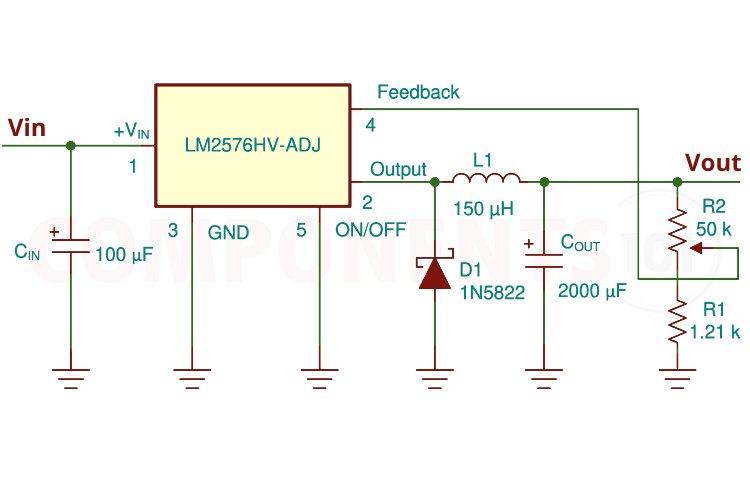
LM2596
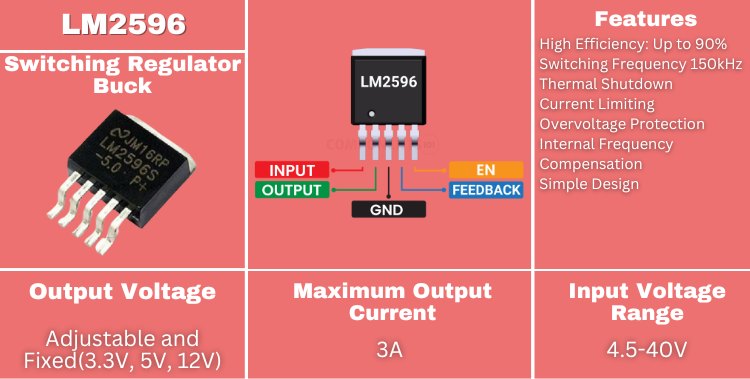
The LM2596 is a step-down (buck) switching regulator that provides high efficiency and ease of use. It is capable of driving a 3A load with excellent line and load regulation. The LM2596 is available in fixed output voltages of 3.3V, 5V, 12V, and an adjustable version. Its switch-mode operation ensures high efficiency, while features like internal frequency compensation, thermal shutdown, and current limit protection enhance reliability. It is commonly used in applications requiring efficient voltage regulation and robust performance.
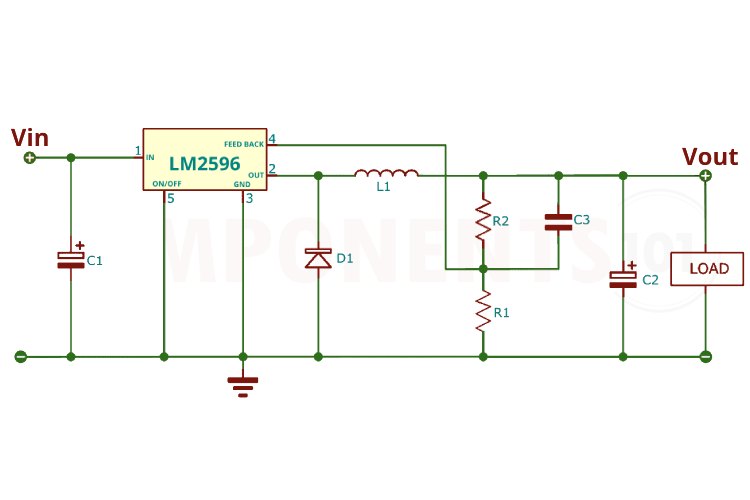
TPS54321
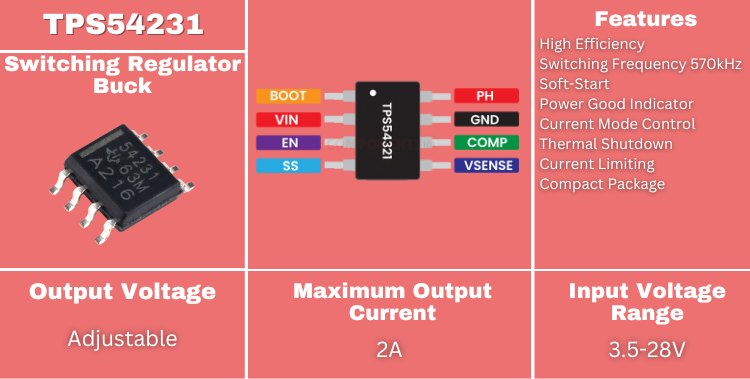
The TPS54231 is a 2-A non-synchronous buck converter with an integrated low RDS(on) high-side MOSFET. To increase efficiency at light loads, the chip features a pulse-skipping Eco-mode feature. Furthermore, the 1-µA shutdown supply current allows the device to be used in battery-powered applications. Current mode control with internal slope compensation simplifies the external compensation calculations and reduces component count. The hysteresis of the input Undervoltage lockout can be programmed using a simple voltage divider. An overvoltage transient protection circuit limits voltage overshoots during startup and transient conditions. It also features standard protections such as thermal shutdown, current limiting and short circuit protection.
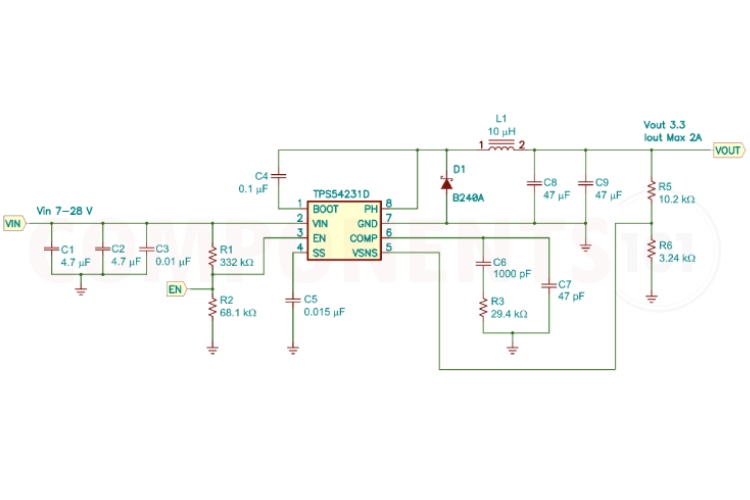
MP1584
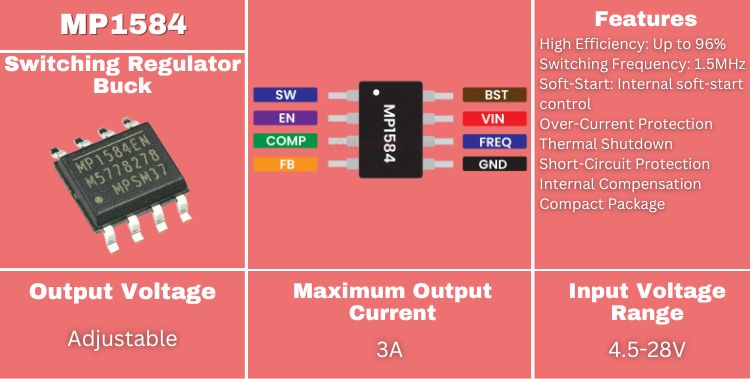
The MP1584 is a high-frequency, step-down (buck) switching regulator with an integrated high-side MOSFET. It can provide up to 3A of continuous output current from a wide input voltage range. The MP1584 features a 1.5MHz fixed switching frequency, allowing for a compact design with very minimal external components. It also includes features like soft-start, thermal shutdown, and over-current protection, making it suitable for a variety of applications where high efficiency and compact size are required.
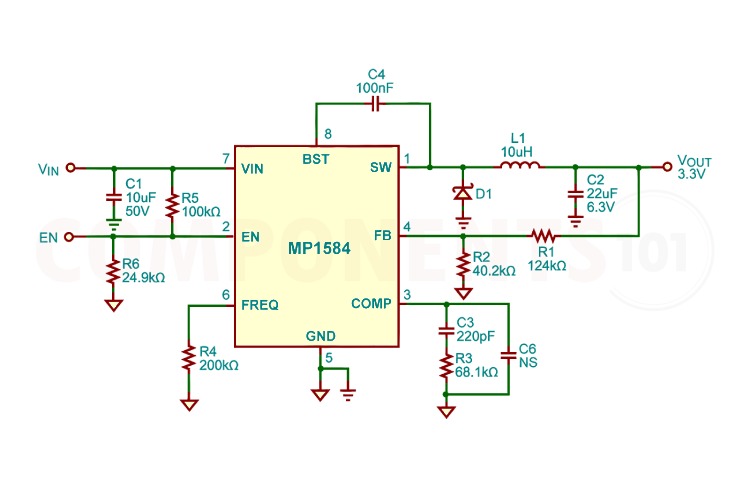
XL4005
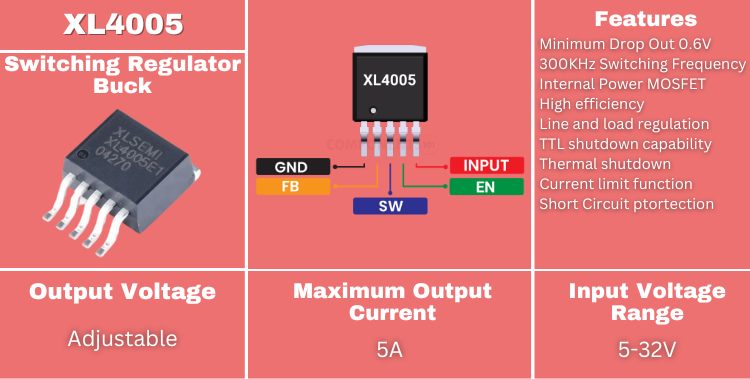
The XL4005 is a high-efficiency step-down DC-DC converter capable of delivering up to 5A of output current. It operates over a wide input voltage range and features a fixed 180kHz switching frequency. The XL4005 includes internal compensation, thermal shutdown, and current limit protection, ensuring reliable operation. Its high efficiency and ability to drive large loads make it suitable for power-hungry applications such as LED drivers and battery chargers.
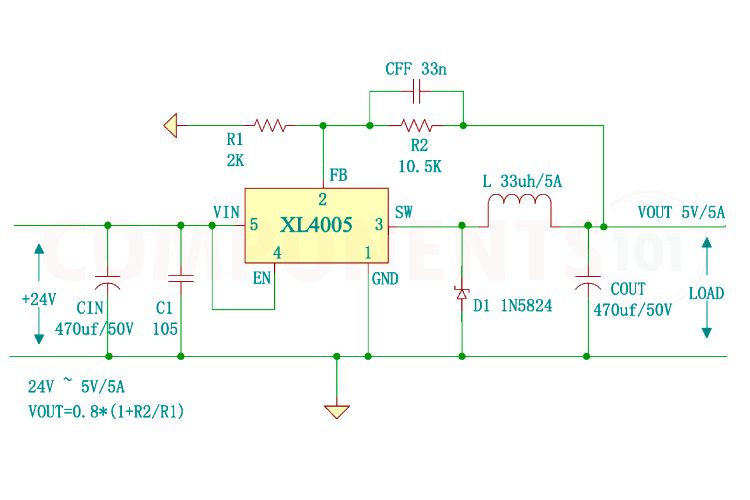
XL4015
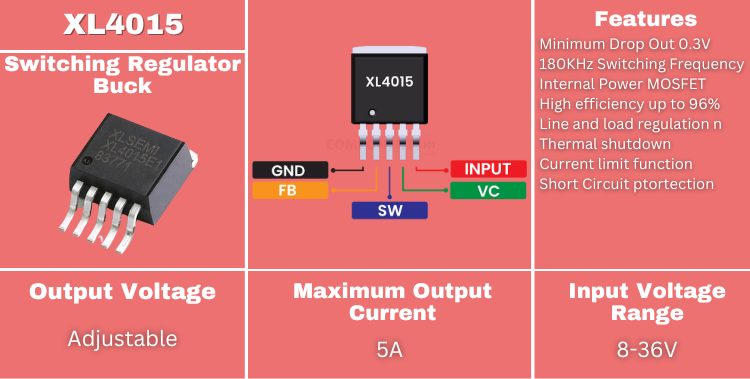
The XL4015 is a high-power step-down (buck) DC-DC converter that can provide up to 5A of output current with high efficiency. It operates over a wide input voltage range and has a fixed 180kHz switching frequency. The XL4015 includes features such as thermal shutdown, current limit protection, and soft-start. Its robust design and high current capability make it ideal for applications like LED lighting, power supply modules, and battery charging systems.
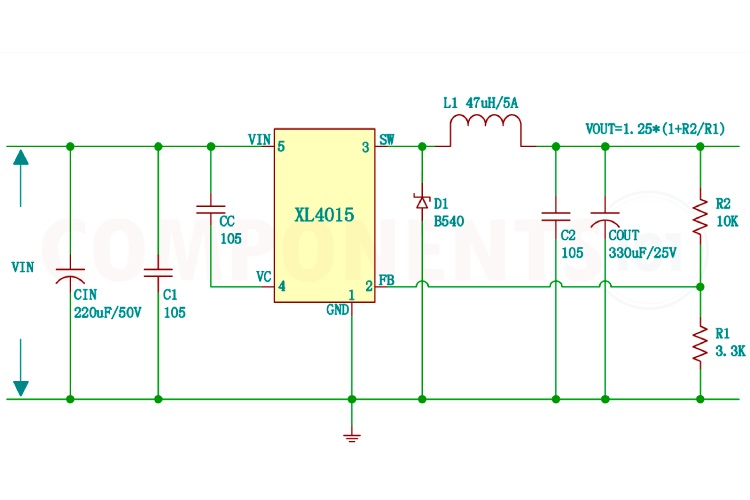
LM2577
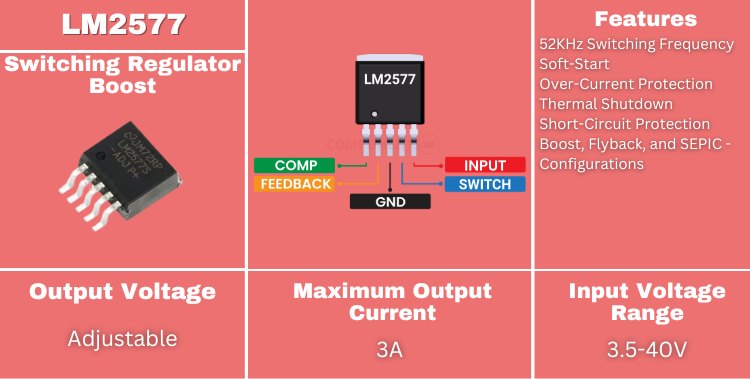
The LM2577 is a very popular boost converter capable of providing high efficiency and reliable performance. It can deliver output currents up to 3A and is available. The LM2577 includes an internal oscillator, frequency compensation, and protection features like current limiting and thermal shutdown. It is commonly used in applications requiring voltage step-up, such as battery-powered devices and power supply designs.
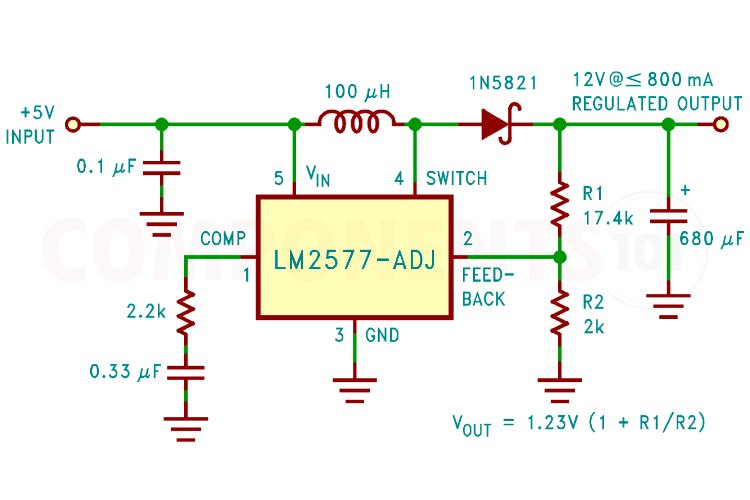
MT3608
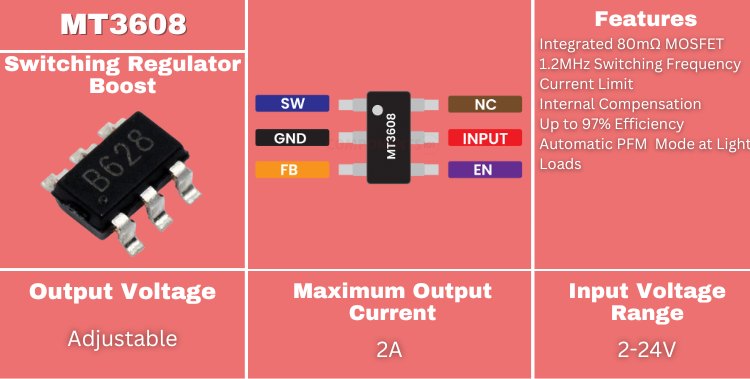
The MT3608 is a compact and efficient boost converter capable of delivering up to 2A of output current. It operates over a wide input voltage range and features a fixed switching frequency of 1.2MHz. The MT3608 includes internal compensation, soft-start, and protection features like over-current and thermal shutdown. Its high efficiency and small form factor make it ideal for portable devices and battery-powered applications.
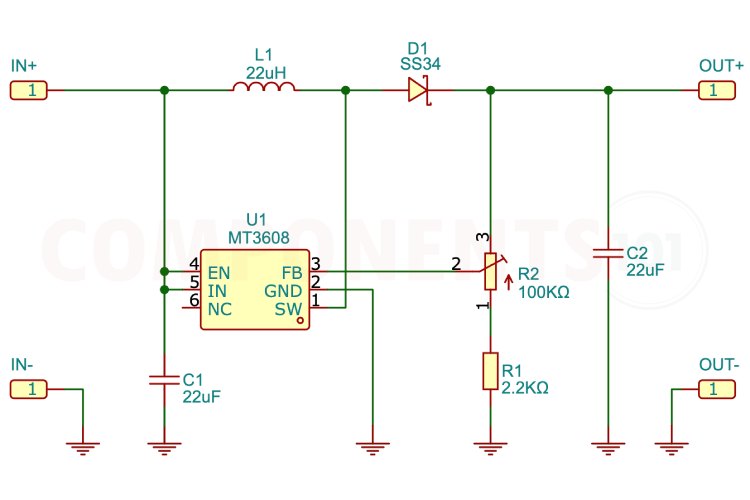
XL6009

The XL6009 is a high-efficiency boost converter that can deliver up to 4A of output current. It operates over a wide input voltage range and has a fixed 400kHz switching frequency. The XL6009 includes features such as internal frequency compensation, soft-start, and thermal shutdown. Its high efficiency and ability to drive large loads make it suitable for applications like power supply modules, LED drivers, and battery charging systems.
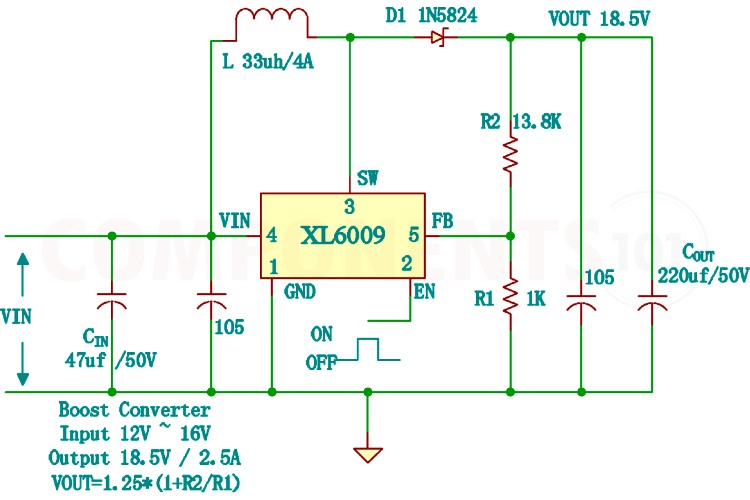
XL6019
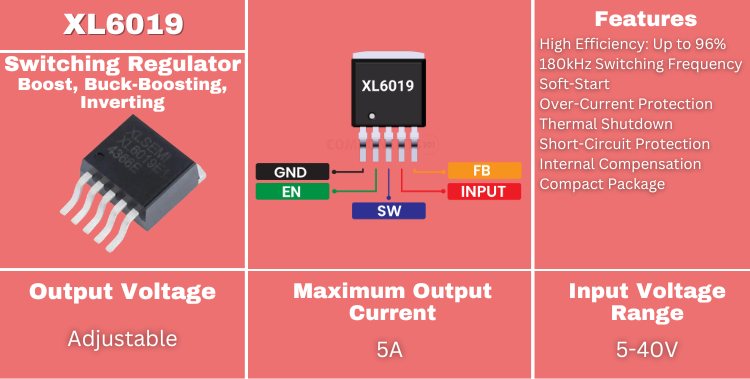
The XL6019 is a high-power boost converter capable of delivering up to 5A of output current. It operates over a wide input voltage range and features a fixed 180kHz switching frequency. The XL6019 includes internal compensation, soft-start, and protection features like thermal shutdown and over-current protection. Its high efficiency and robust design make it ideal for demanding applications requiring reliable voltage step-up.

MC34063
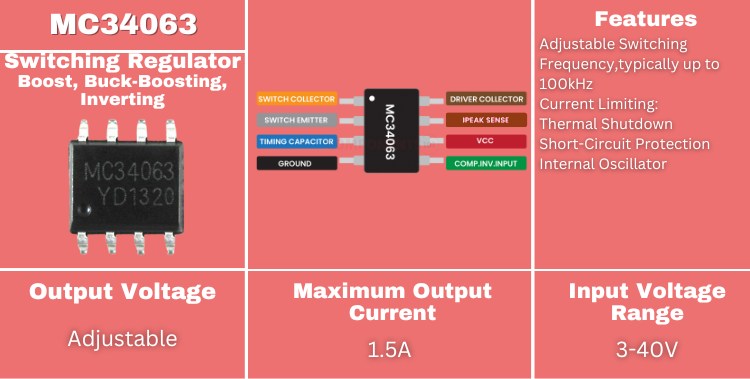
The MC34063 is a versatile DC-DC converter IC that can be configured for boost, buck, and inverting applications. It operates over a wide input voltage range and can deliver output currents up to 1.5A. The MC34063 includes an internal oscillator, current limiting, and thermal shutdown features. Its flexibility and ease of use make it a popular choice for a variety of power supply designs, including battery-powered devices and automotive applications.
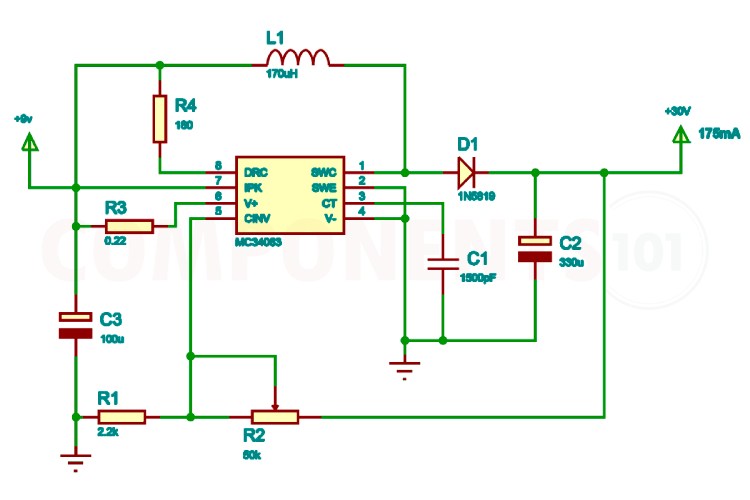
LT1070
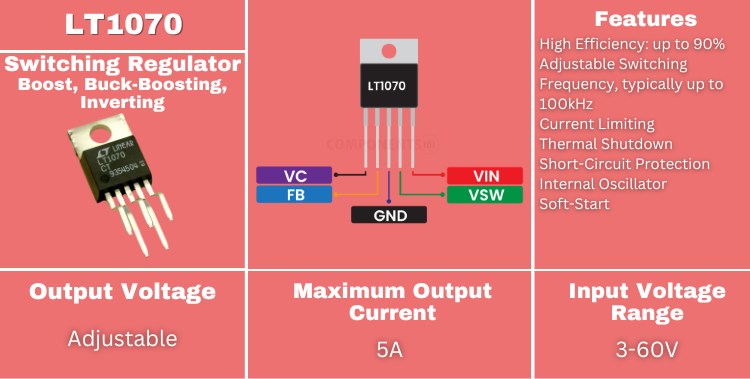
The LT1070 is a high efficiency switching regulator with a wide input voltage range and versatile configuration options. It can be used in boost, buck, and inverting applications, providing output currents up to 5A. The LT1070 features an internal oscillator, frequency compensation, and protection features like current limiting and thermal shutdown. Its flexibility and reliability make it a popular choice for a wide range of power supply designs, including industrial and automotive applications.
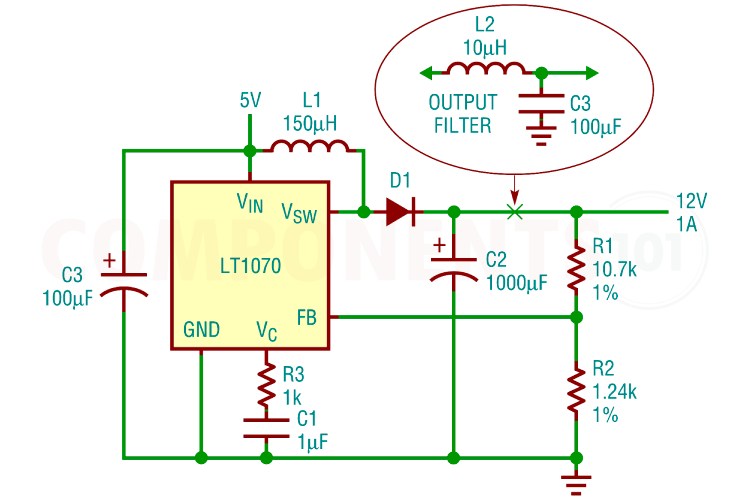
About WIN SOURCE Electronics: With 24 years of experience in the global electronics market, WIN SOURCE is committed to ensuring that your supply chain operates efficiently. With its expertise and precise matchmaking capabilities, WIN SOURCE helps you to successfully source and supply electronic products, supporting your business success.








